|
Bristol Fighter
Debut: 2004
Maker: Bristol
Predecessor: no |
|
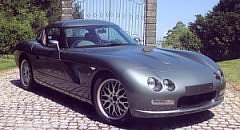 If
you have £230,000 to spend on a supercar and you are tired of
those “mainstream” brands like Lamborghini, Ferrari and Porsche, or you
just don’t like Pagani Zonda, or you are simply a bit mad, you may buy
this Bristol Fighter. It has a 525 hp V10 engine, will go to 210 mph
and finish 0-60 in 4.0 seconds. Moreover, no more than 20 cars will be
built per year in Bristol’s rather ancient and human-intensive factory,
making it a perfect car for collectors. If
you have £230,000 to spend on a supercar and you are tired of
those “mainstream” brands like Lamborghini, Ferrari and Porsche, or you
just don’t like Pagani Zonda, or you are simply a bit mad, you may buy
this Bristol Fighter. It has a 525 hp V10 engine, will go to 210 mph
and finish 0-60 in 4.0 seconds. Moreover, no more than 20 cars will be
built per year in Bristol’s rather ancient and human-intensive factory,
making it a perfect car for collectors.
The company
Bristol
is a small British luxurious car specialist, mostly unknown to the rest
of the world. Previously being an aircraft maker, it diversified into car production business in
1946. As the aircraft division merged with British Aerospace in 1960,
the car division went into private hands. Company owner Tony Crook is a
strange guy. He kept the company ancient and low key. He never really
advertised his cars, never allowed motoring journalists to drive his
cars. This made Bristol the most mysterious cars in the world.
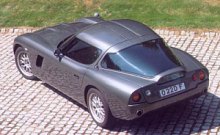 So, what cars does it offer? in
the past 30 years, Bristol produced just a single model, although it appeared in various
forms and names. It was originally called 603, then Britannia, Brigand
and eventually Blenheim. The latter has been running from 1994 until today.
These cars, like their maker, were the strangest in the world. They had
a strange look, an ancient Chrysler pushrod V8 and an outdated chassis,
but strangely, the body panels were made of aluminum like aircrafts. As
strange as the contemporary Rolls-Royce, they did not disclose power
and torque figures. But strangest of all, although they cost as much as
Rolls-Royce, Bristol still found a dozen or so loyal customers a year
to keep its workshop, its sole showroom in London and its sole salesman
(i.e. Tony Crook himself) surviving. This is probably the strangest
story in automotive industry. So, what cars does it offer? in
the past 30 years, Bristol produced just a single model, although it appeared in various
forms and names. It was originally called 603, then Britannia, Brigand
and eventually Blenheim. The latter has been running from 1994 until today.
These cars, like their maker, were the strangest in the world. They had
a strange look, an ancient Chrysler pushrod V8 and an outdated chassis,
but strangely, the body panels were made of aluminum like aircrafts. As
strange as the contemporary Rolls-Royce, they did not disclose power
and torque figures. But strangest of all, although they cost as much as
Rolls-Royce, Bristol still found a dozen or so loyal customers a year
to keep its workshop, its sole showroom in London and its sole salesman
(i.e. Tony Crook himself) surviving. This is probably the strangest
story in automotive industry.
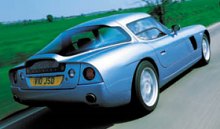 If Bristol continue surviving
in that way, it would not have caught my interest. Luckily, changes
started happening since 1997 when Toby Silverton entered the scene.
Crook eventually sold the company to Silverton in 2001, by then the
latter was already developing an all-new Bristol, the Fighter. The
Fighter is a 2-seater GT. Unlike Blenheim, it is thoroughly modern –
well, almost modern. Although you still can’t compare it with proper
modern supercars, you can’t help amazing how well Bristol did from its
small workshop. If Bristol continue surviving
in that way, it would not have caught my interest. Luckily, changes
started happening since 1997 when Toby Silverton entered the scene.
Crook eventually sold the company to Silverton in 2001, by then the
latter was already developing an all-new Bristol, the Fighter. The
Fighter is a 2-seater GT. Unlike Blenheim, it is thoroughly modern –
well, almost modern. Although you still can’t compare it with proper
modern supercars, you can’t help amazing how well Bristol did from its
small workshop.
The Fighter
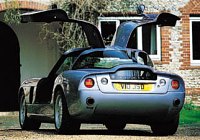 From any angle, the Fighter is
an unusual machine. It is not especially beautiful, but its semi-retro
shape is definitely unique. The first you will notice is how tall,
narrow and short it is compare with other supercars. For example, it is
84 mm taller, 113 mm narrower and 236 mm shorter than Mercedes SLR
McLaren. The tall bubble roof is designed to accommodate passengers up
to 6' 7” tall. The narrow and short body allows it to slip in towns and
typical British back roads easily. Regardless of the usual supercar
rules, Bristol really does things differently. From any angle, the Fighter is
an unusual machine. It is not especially beautiful, but its semi-retro
shape is definitely unique. The first you will notice is how tall,
narrow and short it is compare with other supercars. For example, it is
84 mm taller, 113 mm narrower and 236 mm shorter than Mercedes SLR
McLaren. The tall bubble roof is designed to accommodate passengers up
to 6' 7” tall. The narrow and short body allows it to slip in towns and
typical British back roads easily. Regardless of the usual supercar
rules, Bristol really does things differently.
To ease access of the cabin, Fighter employs a pair of Mercedes
300SL-style Gullwing doors. Cross the not-too-wide sills and drop onto
the electrically adjustable leather seat, you can enjoy vast of head
and leg room. A usefully large luggage loading area is also found
under the liftback, behind the occupants. Thanks to the low waist line,
slim pillars and wrap-around glass shields, the Fighter offers
incomparable forward and rearward visibility. Bristol really does
things differently.
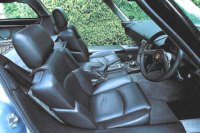 The Fighter was designed by
ex-Brabham and Aston Martin racecar engineer Max Boxstrom. It is
covered with aluminum body panels in Bristol's tradition. The body was
polished in a local university's wind tunnel and achieves a drag
coefficient of 0.28, which is way lower than other supercars
(Koenigsegg CC8S: 0.30; McLaren F1: 0.31; Lamborghini Murcielago: 0.33;
Ferrari Enzo: 0.36; Mercedes SLR: 0.37; Porsche Carrera GT: 0.39). In
addition to the small frontal area, the streamline body allows the
525-horsepower Fighter to reach 210 mph, theoretically. The Fighter was designed by
ex-Brabham and Aston Martin racecar engineer Max Boxstrom. It is
covered with aluminum body panels in Bristol's tradition. The body was
polished in a local university's wind tunnel and achieves a drag
coefficient of 0.28, which is way lower than other supercars
(Koenigsegg CC8S: 0.30; McLaren F1: 0.31; Lamborghini Murcielago: 0.33;
Ferrari Enzo: 0.36; Mercedes SLR: 0.37; Porsche Carrera GT: 0.39). In
addition to the small frontal area, the streamline body allows the
525-horsepower Fighter to reach 210 mph, theoretically.
Of course, you can question how much downforce it produces. Well,
Bristol just enjoys doing things differently. I suppose it has never
tested the car to 200 mph, neither have its customers. The target
buyers of Fighter are not supposed to be very keen drivers. They are
not supposed to chase Ruf 911s at Autobahn or exploit their cars at
Nurburgring – I wonder what it would be under these circumstances. This
means downforce is not its priority.
The chassis is based on a platform welded and fabricated from steel
sheets, with box section sills, aluminum bulkhead and tubular roll cage
as reinforcement. Floorpan is aluminum honey comb material. As
mentioned, the bodyshell is made of aluminum sheets. Doors and tailgate
are made of carbon fiber. The whole car weighs 1540 kg. Bristol must be
proud that it undercuts the full-carbon-fiber McLaren SLR by 150 kg, as
is the weight distribution of 48% front / 52% rear, which beats SLR by
1% each axle. This is achieved by placing the engine well behind the
front axle.
 Suspension is by
double-wishbones all round. Setting of the springs and dampers are very
soft by supercar standards, although they can be tailor set according
to the taste of buyers. Large ground clearance is employed to deal with
bumpy British roads. Wheels are moderately sized at 18-inch,
wrapping with 285/40 tires. Braking is by 343mm ventilated discs all
round, with 6 and 4 pistons calipers front and rear respectively. Suspension is by
double-wishbones all round. Setting of the springs and dampers are very
soft by supercar standards, although they can be tailor set according
to the taste of buyers. Large ground clearance is employed to deal with
bumpy British roads. Wheels are moderately sized at 18-inch,
wrapping with 285/40 tires. Braking is by 343mm ventilated discs all
round, with 6 and 4 pistons calipers front and rear respectively.
Following the tradition of using Chrysler powertrain, the Fighter
employs the 7996 cc V10 and 6-speed manual gearbox from the previous
generation Chrysler Viper. The mega pushrod V10 was Bristolised
(probably tuned by an American tuner), raising power from 450 hp to 525
hp at 5600 rpm. Maximum torque is increased further to 525 lbft at 3600
rpm. At high speed, the ram air effect generated by the nose intake
even boosts power output to 550 hp !
How does it drive? Well, this is a good question. As Bristol never
offered its cars for journalists to test, you can hardly find any
information. Recently, Autocar finally borrowed a Fighter from an
owner. Predictably, it found the car very special, powerful and fast.
The Viper engine is very torquey, pulling the car from 0 to 60 mph
without a gearchange. On the down side, the Viper's truck-like
gearchange quality is carried over to the Bristol, although the latter
made the gear throw shorter already.
Despite of the tremendous output, Fighter handles its power very well.
Thanks to extra-long wheelbase and traction control (which comes from
the Chrysler engine), it is pretty stable on highway and safe from
oversteer in corners. Unfortunately, the test car was ordered with very
soft springs and stiff dampers, thus it displayed a lot of body
roll and a ride quality neither smooth nor stable. In this way, it does
not handle and ride as you expected for a supercar, at least on this
particular test car.
That said, Bristol Fighter is still the most unusual 200 mph-plus
supercar in the world. Its interpretation is totally different from
other car makers. However, £230,000 can buy you a Lamborghini
Murcielago plus a Porsche 911, or a Maybach, or a new Rolls-Royce. So,
is the Bristol worth it? you pay to be special. |
| The
above report was last updated on 25 Jun
2005. All Rights Reserved. |
Fighter S
|
If 525 hp
and
£230,000 are not high enough, Bristol can offer you a more
powerful Fighter S, with 628 hp output and a price of £256,000 to
show your social status. The V10 engine remains unchanged at 8.0
litres, but it gets increased compression ratio, ported inlet manifold,
modified cylinder heads, lighter intake and exhaust valves, lighter
tappets and valve springs, a high-lift camshaft, modified fuel and
ignition mapping and revised exhaust manifolds and catalysts. The
result is a McLaren-beating 628 horsepower at 5900 rpm (300 rpm up from
the standard engine) and 580 lbft of torque at 3900 rpm. At high speed,
the ram air effect increases power output to a Ferrari-Enzo-matching
660 horsepower. Strangely, Bristol did not reveal any performance
figures for the Fighter S.
But Fighter S has no chassis upgrade to match its added power,
therefore Bristol offers an optional R pack, which is
also available to the standard Fighter. The R pack stands for
“Roadholding”. It includes 10 mm lower ride height, stiffer springs and
dampers, increased steering caster angle, larger 19-inch wheels and
grippier Pirelli P-Zero Rosso tires (285/35ZR19 front; 305/35ZR19
rear). It costs £20,000.
A further option is C pack (stands for “Competition”), which cost
another £20,000. It includes 15 mm lower ride height, race-type
springs, uprated adjustable anti-roll bars and an aerodynamic kit to
increase rear downforce and bring drag coefficient down to only 0.255,
the
lowest record for production cars. |
| The
above report was last updated on 25 Jun
2005. All Rights Reserved. |
|
|